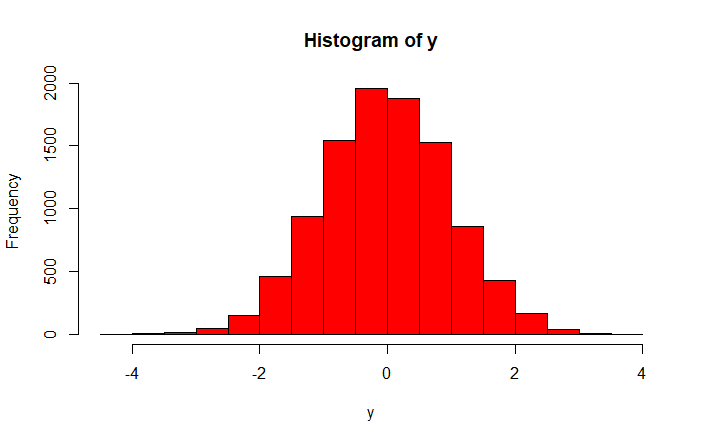Vectors: Vector calculus in R
 Creation of vectors
Creation of vectors
A vector is in R a 1-dimensional array of numbers. I
You can work with both row vectors and column vectors or work with vectors that are considered row or column vectors on the basis of their use.
Row and column vectors, and indeterminate vectors A vector, which are interpreted as a row or column vector on the basis of its use, is created by putting the numbers in a sequence and by using it as argument of the concatenation function c. It looks in the console windows like a row vector, but it is not really the case.
Below are, behind the prompts in an interactive R session, commands to create a vector. With the function array you can create a column or row vector (actually a matrix with 1 column or 1 row). A transposed vector is obtained by the function t .
> v <- c(1,2,3) # a vector in R without dimension
> v
[1] 1 2 3
> class(v) # kind of object (high-level)
[1] "numeric"
> typeof(v) # data type of object (low-level)
[1] "double"
> dim(v)
NULL
> rv <- array(v, dim=c(1,3)) # as row vector
> rv
[,1] [,2] [,3]
[1,] 1 2 3
> class(v)
[1] "matrix"
> typeof(v4)
[1] "double"
> dim(rv)
[1] 1 3
> cv <- array(v, dim=c(3,1)) # as column vector
> cv
[,1]
[1,] 1
[2,] 2
[3,] 3
> t(cv) # transpose of column vector
[,1] [,2] [,3]
[1,] 1 2 3
Dimension and norm With the function dim you can not only determine whether a vector is a row vector, a column vector or a dimensionless vector, but also change the dimension of an R object. With the function length you can determine the dimension of a vector, i.e., the number of components of a vector. Do not confuse this with what is understood in mathematics by the (Euclidean) length of a vector, namely the norm. The norm can be calculated numerically in R with the function norm and there are options to calculate variations.
> v <- c(4,5,6); v # a dimensionless vector
[1] 4 5 6
> length(v)
[1] 3
> norm(v, type="2") # Euclidean length
[1] 8.774964
> dim(v) <- c(3,1) # v now as column vector
> v
[,1]
[1,] 4
[2,] 5
[3,] 6
> norm(v, type="2") # Euclidean length
[1] 8.774964
> norm(v, type="1") # sum of absolute values of components
[1] 15
> norm(v, type="I") # maximum of absolute values of components
[1] 6Special constructions There are also special instructions to create specific vectors; we show a few commonly used constructions, but there exist alternatives.
> v1 <- 5:11; v1 # from 5 up to and including 11
[1] 5 6 7 8 9 10 11
> v2 <- seq(from=10, to=5, by=-2); v2 # from 10 down to and inclusing 5 with steps of -2
[1] 10 8 6
> v3 <- seq(from=0, to=1, length=6); v3 # equidistant distribution of 6 points in [0,1]
[1] 0.0 0.2 0.4 0.6 0.8 1.0
> v4 <- numeric(3); v4 # a dimensionless vector with 3 zeros
[1] 0 0 0
> v4 <- array(0, 3); v4 # alternative construction method
[1] 0 0 0
> v5 <- array(0, dim=c(3,1)); v5 # column vector with 3 zeros
[,1]
[1,] 0
[2,] 0
[3,] 0
> v6 <- logical(3); v6 # row vector with 3 boolean values FALSE
[1] FALSE FLASE FALSE
> v7 <- rep(T, 3); v7 # row vector with 3 boolean values TRUE
[1] TRUE TRUE TRUE
> v8 <- c(); v8 # lege vector
NULL
> length(v7)
[1] 0Concatenating vectors You can create new vectors by concatenating vectors. For this you can use the function c.
>> v1 <- 1:3; v2 <- 4:6; v12 <- c(v1, v2); v12
[1] 1 2 3 4 5 6Randomly generated vectors In simulations one make extensive use of vectors with randomly generated numbers, i.e., with random numbers. There are several instructions for this purpose.
runif |
random numbers between 0 and 1 using a uniform distribution |
sample |
random objects randomly taken from a vector |
rnorm |
random numbers using a normal distribution |
> runif(5, min=0, max=1)
[1] 0.4422001 0.7989248 0.1218993 0.5609480 0.2065314
> # 10 willekeurige gehele getallen tussen 5 en 8 (inclusief):
> sample(5:8, size=10, replace=TRUE)
[1] 6 6 7 8 6 7 6 7 8 5
> # 5 willekeurige getallen volgens standaard normale verdeling:
> rnorm(5)
[1] -0.2793335 -0.7827303 -0.7789972 -0.3748001 -0.3193938
> y <- rnorm(10000)
> hist(y, col="red")



